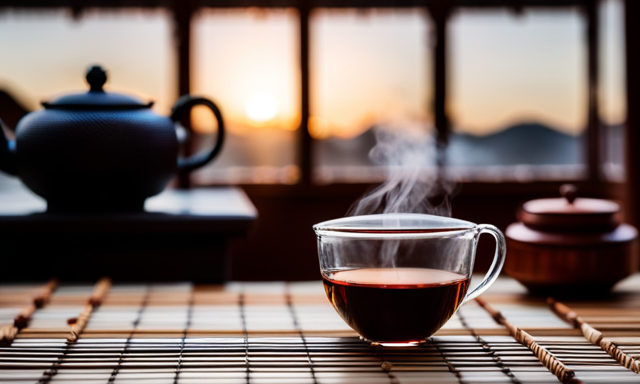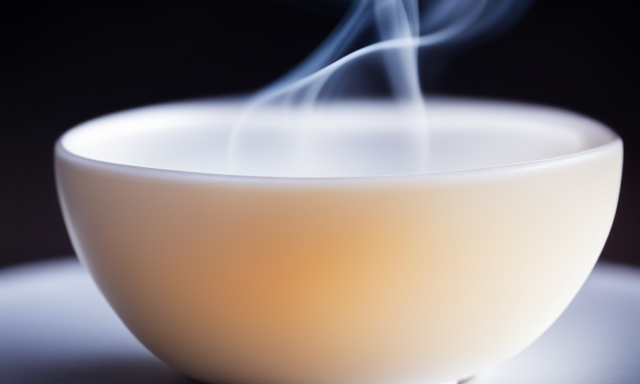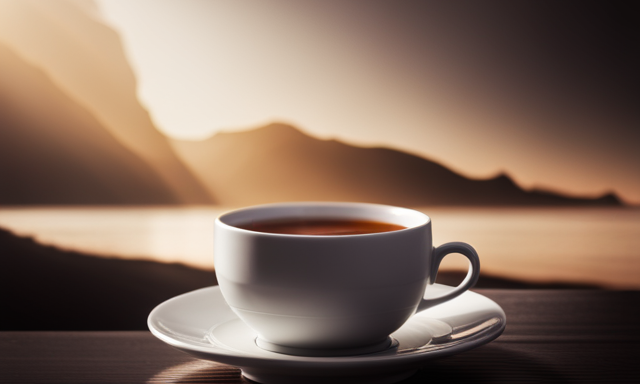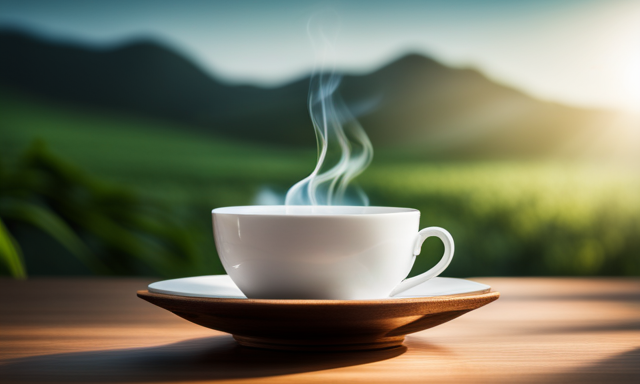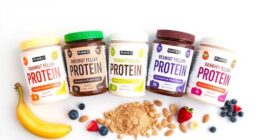Steeping oolong tea requires careful attention to time and taste. It is a delicate balance that brings out the best flavors in this unique brew. As a tea enthusiast, I have spent countless hours experimenting with different steeping methods to discover the perfect infusion.
In this article, I will guide you through the art of steeping oolong tea. I will share my knowledge and expertise to help you achieve a cup that is rich, aromatic, and full of character. From selecting the finest oolong tea leaves to finding the ideal water temperature and steeping time, I will reveal the secrets to unlocking the full potential of this complex beverage.
Whether you prefer a light and floral oolong or a bolder, more robust variety, this article will provide you with the tools and techniques to create your own perfect cup of oolong tea.
So, grab your teapot and let’s embark on a tea-steeping adventure together.
Key Takeaways
- Different types of Oolong tea have unique flavors and aromas, with varieties such as Tie Guan Yin, Da Hong Pao, and Oriental Beauty. Each type undergoes a distinct processing method, resulting in varying levels of oxidation and some teas are scented with flowers or fruits.
- To elevate the taste and aroma of Oolong tea, one can add lemon, honey, or mint to enhance the flavor. Experimenting with different combinations can help find the preferred taste. Proper brewing techniques, such as using high-quality water and adjusting steeping time and temperature, can also maximize the taste and aroma.
- Properly storing Oolong tea is important to maintain its freshness. It is recommended to store it in airtight and opaque containers, such as glass jars or tins with tight-fitting lids. Plastic containers should be avoided to prevent odor absorption. Oolong tea should be kept away from strong-smelling substances and stored in a cool, dry place away from sunlight and heat.
- When steeping Oolong tea, it is generally recommended to steep it for 3-5 minutes with water temperature between 180-200°F (82-93°C). However, specific steeping instructions may vary for different types of Oolong teas. Longer steeping times result in a stronger flavor, and one can experiment with different steeping times to achieve the desired taste.
Understanding Oolong Tea: A Brief Introduction
Understanding Oolong Tea: A Brief Introduction
Oolong tea offers a unique and captivating flavor profile that is achieved through a combination of oxidation and withering processes. This partially fermented tea falls between green and black teas, giving it a distinct taste and aroma.
Oolong tea benefits are numerous, as it is known to promote digestion, boost metabolism, and enhance mental alertness.
Brewing techniques for oolong tea can vary depending on personal preference, but a general guideline is to use one teaspoon of loose leaves per cup and steep for 3-5 minutes in water that is around 185°F. This allows the leaves to unfurl and release their flavors gradually.
Choosing the right oolong tea leaves is crucial in achieving the desired taste, whether it be a lightly floral oolong or a rich and robust one.
Choosing the Right Oolong Tea Leaves
When selecting the perfect oolong leaves, it’s crucial to consider their origin and level of oxidation. Choosing quality leaves is essential for achieving the desired flavor and aroma in your cup of tea. Here are a few tips to help you make the right choice:
- Look for leaves from reputable tea estates, known for producing high-quality oolong tea.
- Consider the level of oxidation you prefer, as it greatly affects the taste. Lightly oxidized oolong tea has a floral and delicate flavor, while heavily oxidized leaves offer a bolder and more robust taste.
- Take into account the processing method, such as whether the leaves are rolled into tight balls or twisted into long strands.
- Pay attention to the appearance of the leaves, as they should be whole and intact, without any signs of damage or discoloration.
By carefully choosing your oolong leaves, you can ensure a delightful brewing experience.
Now, let’s move on to preparing your teapot and tea leaves.
Preparing Your Teapot and Tea Leaves
To ensure a flavorful and aromatic brew, it’s essential to start by properly preparing your teapot and your carefully chosen leaves.
Proper teapot maintenance is crucial for achieving the best results. Before each use, make sure to clean your teapot thoroughly, removing any residue or previous flavors that may affect the taste of your oolong tea. Additionally, consider dedicating a specific teapot for oolong tea to avoid any cross-contamination with other teas.
Equally important is the selection of tea leaves. Oolong tea comes in various forms, each with its own unique flavor profile. Consider the level of oxidation and the region where the tea was grown to find the perfect match for your taste preferences.
Now that your teapot is ready and your tea leaves are selected, let’s move on to the ideal water temperature for steeping oolong tea.
The Ideal Water Temperature for Steeping Oolong Tea
Achieving the perfect water temperature for steeping your oolong tea is like finding the sweet spot on a guitar string. Too hot and it’s a screeching high note, too cold and it falls flat. But when you hit that ideal temperature, it’s a harmonious melody that dances on your taste buds.
To achieve this ideal water temperature, follow these steeping techniques:
- Boil water to around 180-190°F (82-88°C).
- Let the water cool for a few minutes to reach the desired temperature.
- Use a thermometer to ensure accuracy.
- Pour the water over your oolong tea leaves and let it steep for 3-5 minutes.
Maintaining the ideal water temperature is crucial for extracting the delicate flavors and aromas of oolong tea.
Now that we have achieved the perfect water temperature, let’s move on to discussing the appropriate steeping time for light and floral oolong teas.
Steeping Time for Light and Floral Oolong Teas
Indulge in the delicate flavors and floral aromas of light and floral oolong teas by allowing them to dance gracefully in hot water for 2-3 minutes.
Light oolong teas, also known as green oolongs, are lightly oxidized, resulting in a bright and refreshing flavor profile. These teas typically have a subtle floral note and a hint of sweetness. Steeping them for a shorter amount of time preserves their delicate characteristics and prevents the flavors from becoming overpowering.
Floral oolong teas, on the other hand, are slightly more oxidized, giving them a richer and more pronounced floral aroma. Steeping them for a few minutes allows the flavors to fully develop, creating a harmonious balance between the floral notes and the oolong base.
Now, let’s delve into the steeping time for bold and robust oolong teas, where the flavors take a bolder and more robust approach.
Steeping Time for Bold and Robust Oolong Teas
Get ready to experience the bold and robust flavors of oolong teas by allowing them to infuse for 4-5 minutes. This longer steeping time brings out their intense and complex taste profiles.
Did you know that bold oolong teas have higher caffeine content compared to other types of tea? Here are some key differences between bold and robust oolong teas:
- Bold oolong teas have a stronger flavor and a more pronounced aroma.
- Robust oolong teas have a fuller body and a deep, rich taste.
The steeping time for bold oolong teas is typically longer, around 4-5 minutes, to extract their full flavor potential. On the other hand, robust oolong teas can be steeped for a shorter time, around 3-4 minutes, to achieve a balanced taste.
Some popular bold oolong varieties include Da Hong Pao and Tie Guan Yin. Robust oolong varieties include Oriental Beauty and Wuyi Rock tea.
Now, let’s delve into the next section about experimenting with steeping times for personal preference.
Experimenting with Steeping Times for Personal Preference
Discovering your preferred flavor profile is as simple as experimenting with different steeping times. By trying out various steeping durations, you can unlock the unique characteristics of different tea blends and witness the impact of steeping time on tea flavor.
For example, a shorter steeping time of 2-3 minutes may produce a lighter, more delicate flavor profile, while a longer steeping time of 5-6 minutes can result in a bolder and more robust taste. It’s fascinating to witness how subtle changes in steeping time can completely transform the flavor of oolong tea.
From floral and fruity notes to earthy and toasty undertones, the possibilities are endless. As we delve into enhancing the flavor of your oolong tea with additions, let’s explore how these flavors can be further enhanced.
Enhancing the Flavor of Your Oolong Tea with Additions
Boost the flavor of your favorite oolong with a creative twist using carefully selected additions. There are several ways to enhance the aroma and taste of your oolong tea. Here are a few ideas to try:
- Infuse your tea with fresh herbs like mint or lavender to add a refreshing and aromatic twist.
- Sweeten your tea with a touch of honey or a sprinkle of cinnamon for a hint of sweetness.
- Experiment with fruit flavors by adding slices of citrus fruits like orange or lemon to your tea.
- For a creamy and indulgent treat, try adding a splash of milk or a dollop of cream.
- Create a unique blend by mixing different types of oolong tea together to find your perfect flavor combination.
By incorporating these additions, you can elevate the taste and aroma of your oolong tea.
Now, let’s move on to the next section about properly storing oolong tea for longevity.
Properly Storing Oolong Tea for Longevity
To ensure the extended shelf life of your oolong tea, it is crucial to store it properly. The best containers for storing oolong tea are airtight and opaque, as they protect the tea from moisture, light, and air exposure. Glass jars or tins with tight-fitting lids are excellent choices. Avoid using plastic containers, as they can retain odors and affect the flavor of the tea.
Additionally, keep your oolong tea away from strong-smelling substances in your pantry.
To prolong the freshness of your oolong tea, store it in a cool, dry place, away from direct sunlight and heat sources. Ideally, keep it in a temperature-controlled cupboard or cabinet. Remember to seal the container tightly after each use to prevent air from entering.
With your properly stored oolong tea, you can now move on to enjoying your perfect cup of steeped oolong tea.
Enjoying Your Perfect Cup of Steeped Oolong Tea
Now that we’ve learned how to properly store oolong tea to maintain its freshness, let’s move on to the next step: enjoying the perfect cup of steeped oolong tea.
Steeping oolong tea is an art form that requires precision to extract the maximum flavor and aroma. The key is to find the right balance between steeping time and water temperature.
Generally, oolong tea should be steeped for 3-5 minutes in water that is around 180-200°F (82-93°C). However, different oolong teas may have specific steeping instructions, so it’s important to read the packaging or consult a tea expert for guidance.
Once your tea is steeped to perfection, take the time to savor each sip, appreciating the rich and complex flavors that oolong tea has to offer. The art of savoring oolong tea lies in its ability to transport you to a world of tranquility and indulgence.
Frequently Asked Questions
Can I reuse oolong tea leaves for multiple steepings?
Yes, you can reuse oolong tea leaves for multiple steepings. I once steeped the same leaves three times, each time for 2 minutes, and the flavor remained rich and satisfying.
How do I prevent bitterness when steeping oolong tea?
To prevent bitterness when steeping oolong tea, I recommend using a lower water temperature and shorter steeping time. Additionally, try using fewer tea leaves or adjusting the brewing vessel to tea leaf ratio.
Can I cold brew oolong tea?
Cold brewing oolong tea is a great alternative to hot steeping. Did you know that cold brewing enhances the flavor and preserves more antioxidants? Plus, it’s easier on the stomach and can be enjoyed over ice.
What is the difference between high mountain oolong and roasted oolong?
High mountain oolong is grown at higher elevations, resulting in a more delicate and floral flavor profile. Roasted oolong, on the other hand, has a bolder, nuttier taste. Both types offer numerous health benefits, including improved digestion and weight management.
Can I add milk or sweeteners to oolong tea?
You can definitely add milk or sweeteners to oolong tea to enhance its flavor. However, if you want to enhance the flavor without additives, try adjusting the steeping time or water temperature.
Conclusion
In conclusion, steeping oolong tea is an art that requires precision and experimentation. By understanding the different types of oolong tea and choosing the right leaves, preparing the teapot, and using the ideal water temperature, we can create a perfect cup of oolong tea.
Just like a conductor leading an orchestra, we need to find the right balance and timing to bring out the harmonious flavors of oolong tea.
So, grab your teapot and embark on a delightful journey of tea steeping, where every sip is a symphony of flavors.

